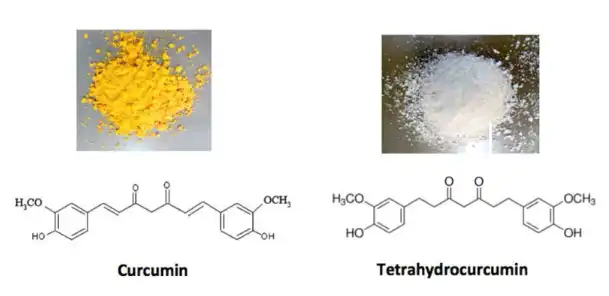Tetrahydrocurcumin powder, a metabolite of curcumin, has gained significant attention in recent years for its potential anti-inflammatory properties. As researchers continue to explore natural alternatives to combat chronic inflammation, tetrahydrocurcumin has emerged as a promising candidate. This bioactive compound, derived from turmeric, offers enhanced bioavailability compared to its parent molecule, curcumin. In this article, we'll delve into the potential benefits of tetrahydrocurcumin powder in addressing inflammation and explore its mechanisms of action.

What are the benefits of tetrahydrocurcumin compared to curcumin?
Tetrahydrocurcumin Powder is a metabolite of curcumin, the primary active compound found in turmeric. While curcumin has been extensively studied for its health benefits, tetrahydrocurcumin offers several advantages that make it a potentially more effective option for addressing inflammation.
One of the key benefits of tetrahydrocurcumin is its enhanced bioavailability. Curcumin is known for its poor absorption and rapid metabolism in the body, which limits its effectiveness. In contrast, tetrahydrocurcumin is more easily absorbed and remains in the bloodstream for a longer duration. This increased bioavailability allows for a more potent and sustained anti-inflammatory effect.
Another advantage of tetrahydrocurcumin is its superior antioxidant properties. Studies have shown that tetrahydrocurcumin exhibits stronger antioxidant activity compared to curcumin, which contributes to its ability to combat oxidative stress and inflammation. This enhanced antioxidant capacity makes tetrahydrocurcumin a powerful tool in neutralizing harmful free radicals and reducing cellular damage associated with chronic inflammation.
Furthermore, tetrahydrocurcumin has demonstrated improved stability in various physiological conditions. Unlike curcumin, which can be sensitive to pH changes and light exposure, tetrahydrocurcumin maintains its structure and activity across a wider range of environments. This stability ensures that the compound remains effective throughout its journey in the body, from ingestion to absorption and utilization by cells.
Research has also indicated that tetrahydrocurcumin may have a more diverse range of biological activities compared to curcumin. While both compounds share many similar properties, tetrahydrocurcumin has shown unique effects on certain cellular pathways and gene expression patterns. This broader spectrum of activity may contribute to its potential therapeutic benefits in addressing various aspects of inflammation and related disorders.
How does tetrahydrocurcumin powder reduce inflammation in the body?
Tetrahydrocurcumin Powder exerts its anti-inflammatory effects through multiple mechanisms, targeting various aspects of the inflammatory response. Understanding these mechanisms provides insight into how this compound can help reduce inflammation in the body.
One of the primary ways tetrahydrocurcumin combats inflammation is by inhibiting pro-inflammatory enzymes. It has been shown to suppress the activity of cyclooxygenase-2 (COX-2) and lipoxygenase (LOX), two enzymes responsible for producing inflammatory mediators. By inhibiting these enzymes, tetrahydrocurcumin helps reduce the production of prostaglandins and leukotrienes, which are key players in the inflammatory cascade.
Tetrahydrocurcumin also modulates the activity of nuclear factor-kappa B (NF-κB), a transcription factor that plays a crucial role in regulating the expression of inflammatory genes. By inhibiting NF-κB activation, tetrahydrocurcumin helps suppress the production of various pro-inflammatory cytokines and chemokines, such as tumor necrosis factor-alpha (TNF-α) and interleukin-6 (IL-6). This downregulation of inflammatory mediators contributes to a reduction in overall inflammation levels in the body.
Another important mechanism by which tetrahydrocurcumin reduces inflammation is through its potent antioxidant properties. Chronic inflammation is often associated with increased oxidative stress, which can further exacerbate tissue damage. Tetrahydrocurcumin acts as a powerful scavenger of reactive oxygen species (ROS) and free radicals, helping to neutralize these harmful molecules and protect cells from oxidative damage. By reducing oxidative stress, tetrahydrocurcumin indirectly contributes to the attenuation of inflammation.
Furthermore, tetrahydrocurcumin has been shown to modulate the activity of various immune cells involved in the inflammatory response. It can influence the behavior of macrophages, neutrophils, and other immune cells, promoting a more balanced immune response and reducing excessive inflammation. This immunomodulatory effect helps maintain a healthy inflammatory balance in the body.
What are the potential applications of tetrahydrocurcumin for inflammatory conditions?
The potential applications of tetrahydrocurcumin for inflammatory conditions are vast and diverse, spanning a wide range of health issues. As research continues to uncover the benefits of this powerful compound, its potential therapeutic uses continue to expand.
One of the most promising applications of Tetrahydrocurcumin Powder is in the management of chronic inflammatory diseases. Conditions such as rheumatoid arthritis, inflammatory bowel disease, and psoriasis are characterized by persistent inflammation that can lead to tissue damage and impaired function. Studies have shown that tetrahydrocurcumin may help alleviate symptoms and reduce inflammation in these conditions by modulating various inflammatory pathways and promoting a more balanced immune response.
Cardiovascular health is another area where tetrahydrocurcumin shows significant potential. Chronic inflammation plays a crucial role in the development and progression of cardiovascular diseases, including atherosclerosis and hypertension. Tetrahydrocurcumin's ability to reduce oxidative stress, inhibit inflammatory mediators, and improve endothelial function may contribute to its cardioprotective effects. Research suggests that tetrahydrocurcumin supplementation could help lower the risk of cardiovascular events and improve overall heart health.
Neurodegenerative disorders, such as Alzheimer's disease and Parkinson's disease, are also closely linked to chronic inflammation in the brain. Tetrahydrocurcumin's neuroprotective properties, combined with its anti-inflammatory and antioxidant effects, make it a promising candidate for supporting brain health and potentially slowing the progression of these disorders. Studies have shown that tetrahydrocurcumin can help reduce neuroinflammation, protect neurons from oxidative damage, and improve cognitive function in animal models of neurodegenerative diseases.
In the field of metabolic health, tetrahydrocurcumin has shown potential in addressing inflammation associated with obesity and diabetes. Chronic low-grade inflammation is a hallmark of metabolic syndrome and contributes to insulin resistance and other metabolic disturbances. By reducing inflammation and oxidative stress, tetrahydrocurcumin may help improve insulin sensitivity, regulate blood sugar levels, and support healthy weight management.
Tetrahydrocurcumin's anti-inflammatory properties also make it a promising candidate for supporting skin health. Inflammatory skin conditions such as acne, eczema, and photoaging may benefit from the topical or oral application of tetrahydrocurcumin. Its ability to modulate inflammatory mediators and protect against oxidative damage could help improve skin barrier function, reduce redness and irritation, and promote overall skin health.
In conclusion, tetrahydrocurcumin powder offers significant potential in addressing inflammation through various mechanisms. Its enhanced bioavailability, potent antioxidant properties, and diverse biological activities make it a promising natural alternative for managing inflammatory conditions. As research continues to uncover the full spectrum of tetrahydrocurcumin's benefits, it may become an increasingly valuable tool in the fight against chronic inflammation and its associated health challenges.
If you are also interested in this product and want to know more product details, or want to know about other related products, please feel free to contact lea_slsbio@163.com,WhatsApp+86 13193326505.

References
- Aggarwal, B. B., & Harikumar, K. B. (2009). Potential therapeutic effects of curcumin, the anti-inflammatory agent, against neurodegenerative, cardiovascular, pulmonary, metabolic, autoimmune and neoplastic diseases. The international journal of biochemistry & cell biology, 41(1), 40-59.
- Panahi, Y., Hosseini, M. S., Khalili, N., Naimi, E., Majeed, M., & Sahebkar, A. (2015). Antioxidant and anti-inflammatory effects of curcuminoid-piperine combination in subjects with metabolic syndrome: A randomized controlled trial and an updated meta-analysis. Clinical nutrition, 34(6), 1101-1108.
- Murugan, P., & Pari, L. (2006). Antioxidant effect of tetrahydrocurcumin in streptozotocin–nicotinamide induced diabetic rats. Life sciences, 79(18), 1720-1728.
- Somparn, P., Phisalaphong, C., Nakornchai, S., Unchern, S., & Morales, N. P. (2007). Comparative antioxidant activities of curcumin and its demethoxy and hydrogenated derivatives. Biological and Pharmaceutical Bulletin, 30(1), 74-78.
- Zhao, J. F., Ching, L. C., Huang, Y. C., Chen, C. Y., Chiang, A. N., Kou, Y. R., ... & Lee, T. S. (2012). Molecular mechanism of curcumin on the suppression of cholesterol accumulation in macrophage foam cells and atherosclerosis. Molecular nutrition & food research, 56(5), 691-701.
- Sandur, S. K., Pandey, M. K., Sung, B., Ahn, K. S., Murakami, A., Sethi, G., ... & Aggarwal, B. B. (2007). Curcumin, demethoxycurcumin, bisdemethoxycurcumin, tetrahydrocurcumin and turmerones differentially regulate anti-inflammatory and anti-proliferative responses through a ROS-independent mechanism. Carcinogenesis, 28(8), 1765-1773.
- Begum, A. N., Jones, M. R., Lim, G. P., Morihara, T., Kim, P., Heath, D. D., ... & Cole, G. M. (2008). Curcumin structure-function, bioavailability, and efficacy in models of neuroinflammation and Alzheimer's disease. Journal of Pharmacology and Experimental Therapeutics, 326(1), 196-208.
- Yodkeeree, S., Chaiwangyen, W., Garbisa, S., & Limtrakul, P. (2009). Curcumin, demethoxycurcumin and bisdemethoxycurcumin differentially inhibit cancer cell invasion through the down-regulation of MMPs and uPA. The Journal of nutritional biochemistry, 20(2), 87-95.
- Feng, T., Wei, Y., Lee, R. J., & Zhao, L. (2017). Liposomal curcumin and its application in cancer. International journal of nanomedicine, 12, 6027.
- Prasad, S., Tyagi, A. K., & Aggarwal, B. B. (2014). Recent developments in delivery, bioavailability, absorption and metabolism of curcumin: the golden pigment from golden spice. Cancer research and treatment: official journal of Korean Cancer Association, 46(1), 2.

